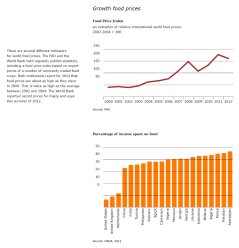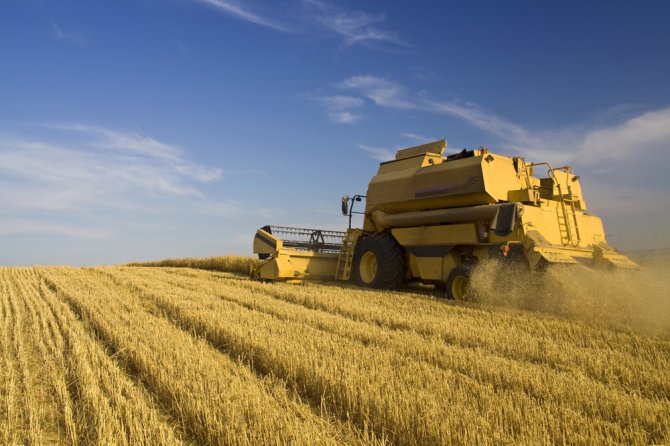Food prices
Soaring food prices frequently dominate the world news. High prices are often associated with increasing hunger and reduced nutrition security. The relationship between food prices and security varies with time and place, however.
Food prices are determined by supply and demand. Supply and demand, however, hardly react to price changes, both are price inelastic. Conversely, small shifts in demand or supply lead to substantial changes in market prices. As demand increases – through population growth and higher disposable incomes – prices rise very quickly. The same is true if the supply decreases, for example as a result of crop failures.
In the Netherlands, about 14 percent of the total household budget is earmarked for food
Reversed process
Food production has grown faster than global food demand over the past 50 years, explaining the downward trend in food prices up to 2000. However, since early 2000s this process has reversed. The export price of some conventional crops has approximately doubled between 2003 and 2008, according to figures from the FAO. This is not due to lower production. The FAO and the OECD expect that the increase in food production (2.3 percent per year) will remain ahead of the world's population (1.0%) until 2021. Other drivers of demand growth, such as increases in wealth and demand for biofuels and livestock feed, are therefore important explanations for the observed price increases. The effects of fluctuating food prices are not the same for every country and individual. When the prices of maize, wheat and rice rose sharply in 2008, there were worldwide protests, leaving several dead and wounded in places such as Cameroon.
In Haiti, Egypt, Mauritania and Mozambique, demonstrations against high food prices led to looting and clashes with the police. Thailand and Pakistan deployed the army to monitor food warehouses. High food prices caused hunger and poverty in these low-income countries. Things remained quiet in our region, as in the rest of the developed world, where the amount that people spend on food is relatively low. In the Netherlands, about 14 percent of our total household budget is earmarked for food. Moreover, the cost of primary foods – grain, sugar, etc. – only partly determines the price of the final product. Marketing, transportation, processing and trading costs are all important components of the consumer price. All of these elements dampen the impact of prices on the world food market. The increased use of food banks in Western countries is largely the result of other problems, such as a loss of jobs and income, high housing costs and debt.

Consuming less
In developing countries, poor households spend a large part of their income on largely unprocessed food. People thus respond to higher food prices by consuming less food or skipping more expensive and nutritious foods, such as meat and vegetables. They base their diet increasingly on staple crops like grain and sugar. (Food) poverty in these countries varies geographically. Local conditions – harvest, stockpiling, policies – determine the food prices, which are not always in line with the world market and prices. Research of Koos Gardebroek, associate professor of agricultural economics and rural policy, shows that, even within a region, prices may react differently to global price fluctuations.
The further a place is from major commercial centres, the greater the impact of local conditions. This may mean prices rise or even fall less rapidly. However, it can also cause the price shock to be that much greater.The magnitude of the differences in price fluctuations was established in research by the FAO. While the price of rice, maize and wheat on the world market increased by 7, 11 and 14 percent respectively between 2011 and 2012, the price of rice increased by 90 percent in Malawi and fell by 23 percent in Mozambique. Wheat was 52 percent more expensive in Sudan and 30 percent cheaper in El Salvador. Maize costs 174 percent more than a year earlier in Malawi, while its price fell by 49 percent in Nicaragua. The overall impact of the global price on the prevention of hunger appeared limited, partly because local prices barely changed in China, India and Indonesia.

Price effect biofuels
In addition to supply, demand is also relevant. In this regard economists do not just look at the current situation in the food market. Although the exact effect is difficult to determine, speculation – i.e., the trader and the farmer agreeing on a price before the harvest, giving the farmer security and the trader an opportunity for higher profit – can have an impact on food prices as well. A minor part of the increase in demand is currently driven by biofuels. Food crops such as maize and sugar are used for the first generation of biofuels (the proportion of the food crops being converted into energy is relatively small, however).
Since this market is growing – due among other things to compulsory requirements by governments in Europe, the US and Brazil – it creates an upward pressure on prices. The negative effects of high food prices – poverty, hunger, political unrest – have a flip side. Medium-term nutrition security may benefit from relatively high food prices, as they encourage farmers to increase production. Furthermore, as farmers profit from higher yields, they can invest in fertiliser and other inputs to increase production. It also becomes more attractive to use fallow land. In the long term, high food prices can lead to increased spending on R&D in agriculture as it is expected to be recouped quickly.